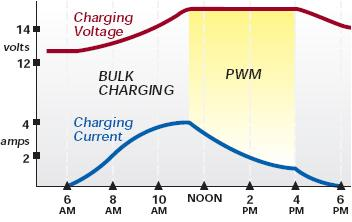SOLAR POWER is the conversion of sunlight into electricity. Photovoltaics convert light into electric current using the photoelectric effect.
Photovoltaics were initially, and still are, used to power small and medium-sized applications, from the calculator powered by a single solar cell to off-grid homes powered by a photovoltaic array. They are an important and relatively inexpensive source of electrical energy where grid power is inconvenient, unreasonably expensive to connect, or simply unavailable. However, as the cost of solar electricity is falling, solar power is also increasingly being used even in grid-connected situations as a way to feed low-carbon energy into the grid.
WHAT NEEDED TO BUILD OFF-GRID SOLAR POWER?
1.) Solar Panel 3.) Battery
2.) Charge Controller 4.) Power Inverter 5.) Breakers
STEP BY STEP TO BUILD OFF-GRID SOLAR POWER +12- VOLTS SYSTEM
Ex. Power Consumption is 0.8KWH per day.
First you need 100 Watts Monocrystalline Solar Panel. Assuming heat of the sun is
8 hours/day. Solar Panel 100 watts X 8 hours = 800WH or 0.8KWH per day.
Solar Panel Specifications:
- Max-power Voltage 19.2 volts
- Max-power Current 5.21 Amperes
- Open-Circuit Voltage 22.8 volts
- Short-Circuit Current 5.64 Amperes
Second determine the current ratings of Solar Charge Controller PWM or MPPT. Since Solar Panel short-circuit current (I) is 5.64 Amps, so you need at least 10 Amps Charge Controller and Fuse or DC breakers between Solar Panel and Solar Charge Controller is also 10 Amps.
Third sizing of Battery Bank (Deep Cycle like Motolite Solar Master). Max-power Current 5.21 Amps X 8 hours/day is 41.68 Ampere-Hour or 41.68AH. So you need 12 Volts 100AH Battery Bank and Full Charge in 2 days. Don't discharge the Battery less than 50% DoD.
Fourth compute what Power Inverter can handle 12V 100AH Battery Bank? 12V X 100AH is 1200WH (use in 1 hour only if 1200W load) Full Charge in 2 days. So you need 12V 220V 60Hz 1200 Watts Power Inverter but I recommend 12V 220V 60Hz 1500 Watts. Some Solar store advise Power Inverter what your appliances or lightning total power load but for me I preferred to use more higher Power Inverter. Since 100W Solar Panel can produce only 0.8KWH/Day, Modified Sine Wave can handle to supply such as Electronics gadgets charger, Electrical Fan and Lightning and etc. Pure Sine Wave much better and can handle Inductive Loads but more Expensive. Fuse or DC breakers between Battery Bank and Power Inverter is 200 Amps.
And for WIRING never use smaller than #10 wire to connect your solar panels to the batteries unless your batteries are less than 5 feet from your panels. Up to 20 feet from the panels you must use wire #10, father you must use #8 or even #6. The farther the bigger wire.
Take Note:
Battery Bank AH depends how much power load and how long to be used.
At last you have now Solar Power Generator from 12VDC to 220VAC 50/60Hz.













